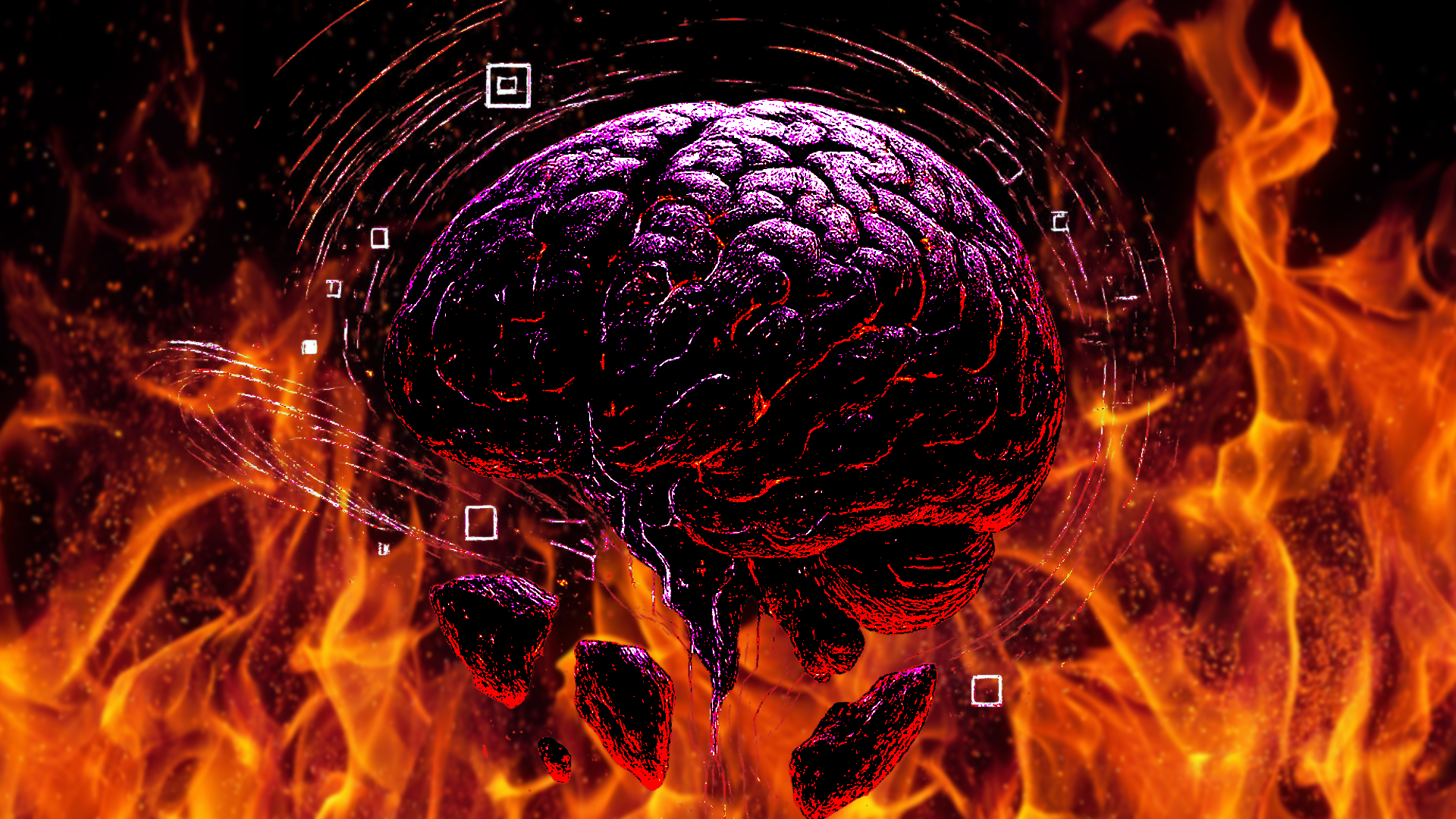Your Brain on Scroll Mode—A Hijacking in Real Time
Read:
- The Poisonous Outcome of Short-Form Content – Part 1: A Hijacked Reward System
- The Poisonous Outcome of Short-Form Content – Part 2: A Hijacking in Real Time
- The Poisonous Outcome of Short-Form Content – Part 3: Intrusive Thoughts and Mental Imagery Pollution
- The Poisonous Outcome of Short-Form Content – Part 4: How It Shows Up in Your Day-to-Day
- The Poisonous Outcome of Short-Form Content – Part 5: Ideological Echo Chambers and Identity Hijack
- The Poisonous Outcome of Short-Form Content – Part 6: How to Detox, Rewire, and Return to Clarity
It doesn’t take long. Just a few swipes. And your brain is no longer yours.
It starts innocently enough: you open TikTok to check a recipe. Or maybe a friend sends you a reel. Five seconds becomes five minutes. Then twenty. An hour passes. You’re not sure what you watched, but you know you feel restless, foggy, and maybe a little gross.
It’s not by accident. It’s by design.
Short-form content isn’t just a distraction. It’s a neurological hijack. A precision-crafted assault on your brain’s most vital systems: attention, memory, decision-making, and motivation.
1. The Dopamine Trap: Your Reward Circuit Under Siege
Every short-form video you swipe is a mini-lottery ticket. Most are mildly stimulating. Some are deeply rewarding. A few are shocking or highly emotional. This pattern mimics the psychology of slot machines—an unpredictable reward schedule that spikes dopamine release and keeps you chasing the next hit.
Research shows that this kind of variable reinforcement is one of the most powerful drivers of addictive behavior (Berridge and Robinson, 2016). The more you engage, the more your brain rewires itself to expect constant novelty. This weakens the prefrontal cortex’s control over impulsive behavior and strengthens the habit loop between cue (boredom), behavior (scrolling), and reward (dopamine spike).
The problem? The reward doesn’t last. Dopamine rises in anticipation of novelty—not during enjoyment. Once the stimulation stops, your brain is left chemically depleted. You feel tired, unmotivated, and oddly dissatisfied.
2. The Collapse of Working Memory and Mental Clarity
Working memory is the mental workspace where we hold and manipulate information. It’s critical for reasoning, learning, and making decisions. But it’s also fragile—easily overloaded by rapid, competing inputs.
Short-form videos bombard the brain with rapid context switching. One second you’re watching a cooking hack, the next it’s a breakup confession, then political commentary, then a cat with sunglasses. Your brain has to constantly reset, suppress irrelevant information, and shift gears—tasks that fatigue the prefrontal cortex (Miller and Cohen, 2001).
Over time, this kind of constant reorientation leads to what neuroscientists call “attention residue” (Leroy, 2009): lingering cognitive clutter that prevents deep focus and sustained thought. That’s why even after you stop watching, your mind feels jumpy, foggy, or disorganized.
3. Hijacking the Default Mode Network (DMN): No Room for Reflection
The Default Mode Network is a set of brain regions active during rest, self-reflection, and creative thought. It’s the system that lights up when you daydream, recall memories, or imagine the future.
But here’s the catch: the DMN requires mental stillness to function. Short-form content interrupts this stillness with relentless stimulation. When you spend hours consuming rapid-fire videos, you inhibit the very network responsible for self-awareness, emotional regulation, and long-term planning (Andrews-Hanna et al., 2014).
That’s why people often report feeling disconnected from themselves, unsure of what they were doing or even thinking, after a long scroll session. Your brain has been hijacked away from introspection and toward reaction.
4. Desensitization and the Numbing of Real-Life Rewards
As you train your brain to seek constant novelty and high-arousal stimuli, you dull its sensitivity to slower, subtler forms of pleasure. A walk in the park, a chapter of a book, or even a deep conversation—these begin to feel underwhelming.
This effect mirrors the neural pattern seen in behavioral addictions, where natural rewards lose their appeal in the face of overactive reward pathways (Volkow et al., 2011). In other words, short-form content teaches your brain that unless something is instantly stimulating, it’s not worth your attention.
This is why life feels “boring” after binging. Not because it is, but because your neural calibration has shifted.
5. A Feedback Loop of Fatigue and Dependency
The more often you use short-form content to relieve boredom, the more dependent you become on it—but the less it actually satisfies. This paradox is rooted in the brain’s diminishing returns system. The first few swipes feel novel. The 40th? Not so much.
Yet you keep going. Why? Because your brain has been trained to chase the possibility of novelty, not the reality of satisfaction.
This creates a feedback loop:
- Mental fatigue leads to scrolling
- Scrolling leads to dopamine depletion and cognitive overload
- Depletion leads to more fatigue, which reinforces the need to scroll again
It’s not just burnout. It’s learned helplessness of the attention system.
The Good News: Neuroplasticity Works Both Ways
Your brain may have been hijacked, but it can also be rewired. Neuroplasticity—the brain’s ability to adapt—means that intentional choices can restore focus, rebuild attention, and retrain reward systems.
Start by:
- Taking intentional scroll breaks (even 24 hours can reset dopamine balance)
- Replacing reactive content with intentional, long-form input (books, documentaries, real conversations)
- Practicing stillness: walks without headphones, mindfulness, or unstructured rest
Even a few minutes of stillness a day can help the DMN re-engage, rebuilding your inner clarity.
Your brain isn’t broken. It’s just overwhelmed. But with awareness and action, you can take the reins back—one quiet, focused moment at a time.
Works Cited:
- Andrews-Hanna, Jessica R., et al. “The Default Network and Self-Generated Thought: Component Processes, Dynamic Control, and Clinical Relevance.” Annals of the New York Academy of Sciences, vol. 1316, no. 1, 2014, pp. 29–52. https://doi.org/10.1111/nyas.12360
- Berridge, Kent C., and Terry E. Robinson. “Liking, Wanting, and the Incentive-Sensitization Theory of Addiction.” The American Psychologist, vol. 71, no. 8, 2016, pp. 670–79. https://doi.org/10.1037/amp0000059
- Leroy, Sophie. “Why Is It So Hard to Do My Work?” Organizational Behavior and Human Decision Processes, vol. 109, no. 2, 2009, pp. 168–179. https://doi.org/10.1016/j.obhdp.2009.04.002
- Miller, Earl K., and Jonathan D. Cohen. “An Integrative Theory of Prefrontal Cortex Function.” Annual Review of Neuroscience, vol. 24, 2001, pp. 167–202. https://doi.org/10.1146/annurev.neuro.24.1.167
- Volkow, Nora D., et al. “Addiction: Decreased Reward Sensitivity and Increased Expectation Sensitivity Conspire to Overwhelm the Brain’s Control Circuit.” BioEssays, vol. 33, no. 9, 2011, pp. 737–744. https://doi.org/10.1002/bies.201100072
Read:
- The Poisonous Outcome of Short-Form Content – Part 1: A Hijacked Reward System
- The Poisonous Outcome of Short-Form Content – Part 2: A Hijacking in Real Time
- The Poisonous Outcome of Short-Form Content – Part 3: Intrusive Thoughts and Mental Imagery Pollution
- The Poisonous Outcome of Short-Form Content – Part 4: How It Shows Up in Your Day-to-Day
- The Poisonous Outcome of Short-Form Content – Part 5: Ideological Echo Chambers and Identity Hijack
- The Poisonous Outcome of Short-Form Content – Part 6: How to Detox, Rewire, and Return to Clarity



